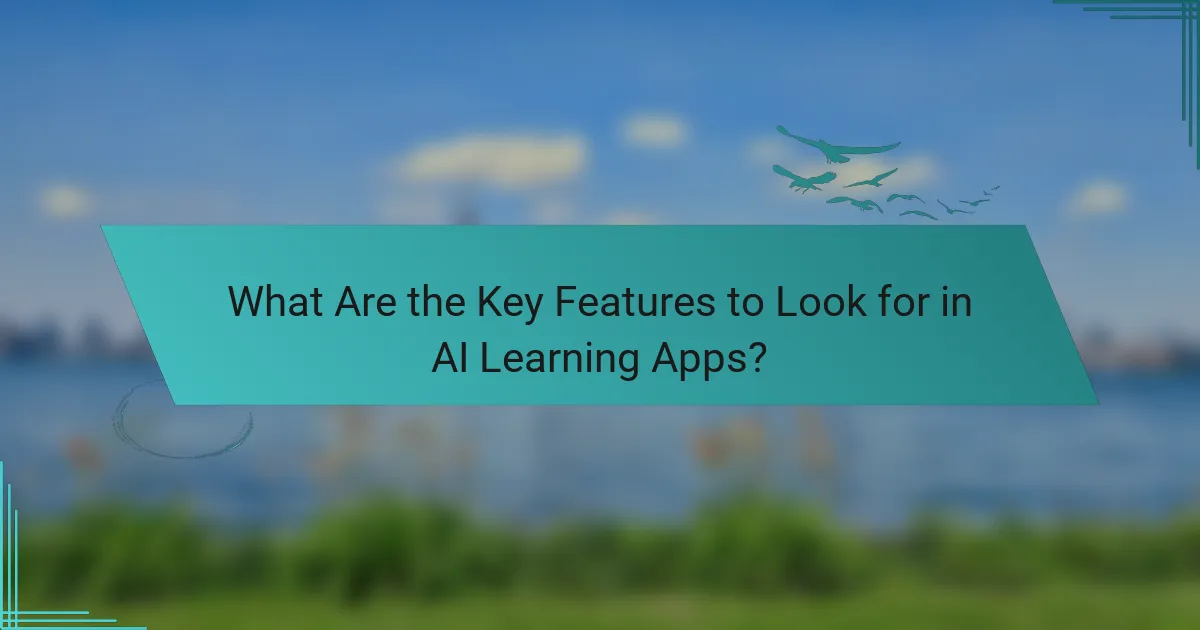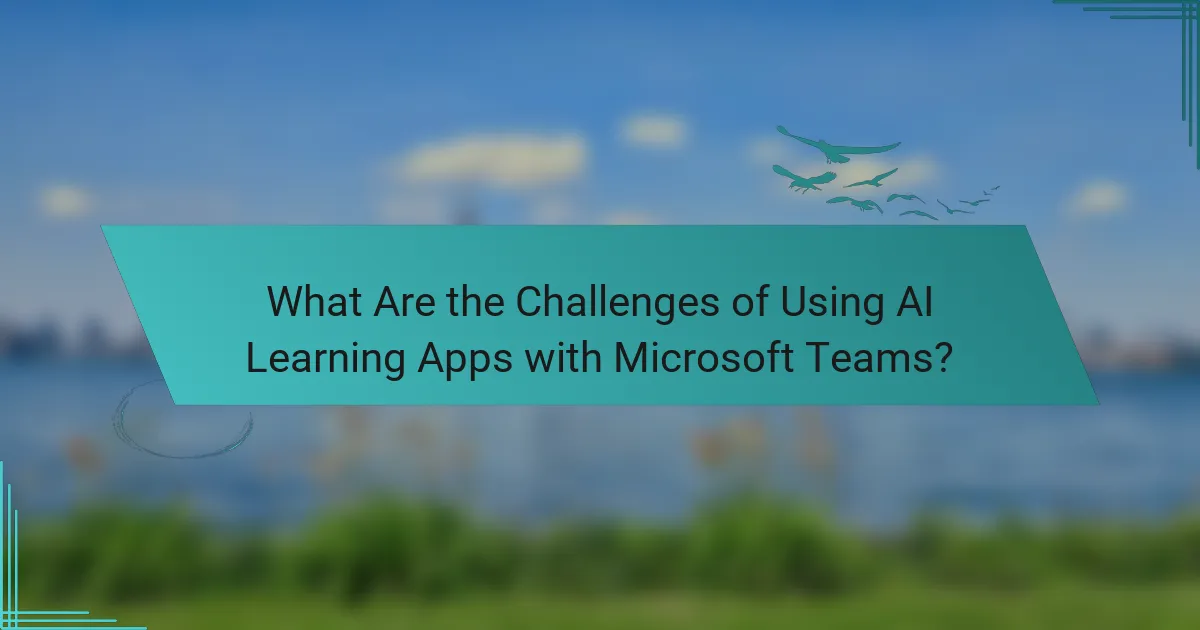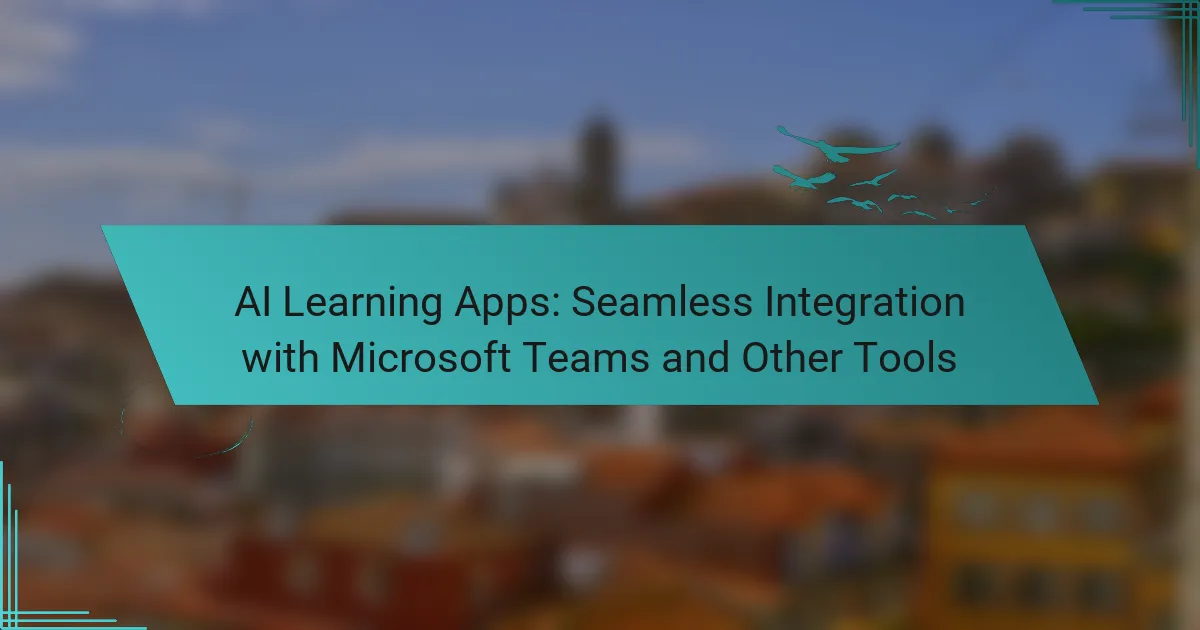AI learning apps are revolutionizing education by seamlessly integrating with Microsoft Teams, enhancing communication and streamlining learning processes. These tools provide direct access to resources within Teams, fostering an interactive and collaborative environment for both educators and learners. By tailoring educational experiences to individual needs, they significantly boost productivity and knowledge retention.

How Do AI Learning Apps Integrate with Microsoft Teams?
AI learning apps integrate with Microsoft Teams by providing tools that enhance communication and streamline educational processes. These integrations allow users to access learning resources directly within Teams, facilitating a seamless experience for both educators and learners.
Direct integration features
Direct integration features of AI learning apps in Microsoft Teams include the ability to share resources, assign tasks, and track progress without leaving the platform. For instance, educators can embed quizzes or learning modules directly into a Teams channel, making it easy for students to engage with the material.
Additionally, many AI learning apps offer real-time analytics that can be accessed within Teams, allowing educators to monitor student performance and engagement levels instantly. This integration minimizes the need to switch between multiple applications, enhancing productivity.
Collaboration enhancements
AI learning apps enhance collaboration in Microsoft Teams by enabling interactive features such as discussion boards and group projects. Students can collaborate on assignments in real-time, sharing insights and resources directly within the Teams environment.
Moreover, these apps often include AI-driven suggestions for group formations based on students’ strengths and weaknesses, fostering a more effective learning environment. This collaborative approach helps build a sense of community among learners, even in remote settings.
Use cases in education
In education, AI learning apps integrated with Microsoft Teams are used for various purposes, including personalized learning experiences and automated grading. For example, teachers can use AI tools to tailor lessons to individual student needs, ensuring that each learner progresses at their own pace.
Another common use case is the implementation of virtual classrooms where instructors can deliver live lessons, supported by AI tools that provide instant feedback and assessments. This approach not only enhances learning outcomes but also keeps students engaged.
Benefits for remote teams
For remote teams, the integration of AI learning apps with Microsoft Teams offers significant benefits, such as improved accessibility to learning materials and flexible scheduling. Team members can access training resources anytime, which is crucial for accommodating different time zones and work schedules.
Additionally, AI tools can facilitate ongoing professional development by providing tailored learning paths based on individual performance metrics. This ensures that team members continuously enhance their skills, contributing to overall team effectiveness and productivity.

What Are the Best AI Learning Apps for Microsoft Teams?
The best AI learning apps for Microsoft Teams enhance collaboration and streamline educational processes. These tools integrate seamlessly with Teams, offering features that support interactive learning and efficient communication.
Microsoft Learning Tools
Microsoft Learning Tools are designed to improve reading and writing experiences for students. They include features like Immersive Reader, which helps with text comprehension through read-aloud capabilities and text spacing adjustments.
These tools can be easily integrated into Microsoft Teams, allowing educators to create a more inclusive learning environment. Teachers can utilize these resources to support diverse learning needs, making lessons more accessible for all students.
Edmodo
Edmodo is a social learning platform that connects educators, students, and parents. It provides a space for sharing resources, assignments, and feedback, all within a secure environment.
When integrated with Microsoft Teams, Edmodo allows for streamlined communication and collaboration on assignments. Educators can create groups, share materials, and track student progress efficiently, fostering a community-focused learning atmosphere.
Nearpod
Nearpod is an interactive learning tool that enables teachers to create engaging lessons with multimedia content. It allows for real-time assessments and feedback, making learning more dynamic.
Integrating Nearpod with Microsoft Teams enhances the learning experience by allowing educators to share lessons directly within Teams. This integration facilitates easy access to interactive content, encouraging student participation and collaboration.
Classcraft
Classcraft gamifies the learning experience by turning education into an interactive game. Students earn rewards and progress through levels based on their academic achievements and behavior.
When used with Microsoft Teams, Classcraft can motivate students to engage more deeply with their studies. Teachers can track student progress and customize challenges, making learning both fun and effective.

How Can AI Learning Apps Enhance Team Productivity?
AI learning apps can significantly boost team productivity by providing tailored educational experiences that adapt to individual needs. These tools streamline training processes, enhance knowledge retention, and facilitate collaboration within platforms like Microsoft Teams.
Automated feedback systems
Automated feedback systems in AI learning apps provide instant evaluations of team members’ performance. This immediate response helps learners identify areas for improvement without waiting for manual assessments, which can delay progress.
For example, an AI tool might analyze a user’s responses in real-time during a training module, offering suggestions or corrections based on their input. This continuous feedback loop fosters a more engaging learning environment and encourages ongoing skill development.
Personalized learning paths
Personalized learning paths allow team members to engage with content that aligns with their specific roles and skill levels. AI algorithms assess individual performance and preferences, curating a unique educational journey for each user.
By focusing on relevant topics, such as project management for team leaders or technical skills for developers, these apps ensure that learning is both efficient and applicable. This targeted approach can lead to faster skill acquisition and improved job performance.
Data analytics for performance tracking
Data analytics in AI learning apps enables organizations to monitor team performance and learning outcomes effectively. By collecting and analyzing user data, managers can gain insights into overall productivity and identify trends or gaps in knowledge.
For instance, tracking completion rates and assessment scores can help pinpoint which areas require additional training resources. This data-driven approach supports informed decision-making and helps allocate training budgets more effectively, ensuring that investments yield maximum returns.

What Are the Key Features to Look for in AI Learning Apps?
When selecting AI learning apps, focus on features that enhance integration, usability, and support. These elements ensure that the app not only fits seamlessly into your existing workflow but also provides a user-friendly experience and adequate resources for learning.
Integration capabilities
Integration capabilities are crucial for AI learning apps, especially when using platforms like Microsoft Teams. Look for apps that can easily connect with existing tools and systems, allowing for smooth data sharing and communication.
Consider whether the app supports APIs or has pre-built connectors for popular software. This can significantly reduce setup time and improve user experience, as learners can access resources without switching between multiple applications.
User interface design
A well-designed user interface is essential for maximizing engagement with AI learning apps. The interface should be intuitive, allowing users to navigate easily and find resources without confusion.
Pay attention to layout, color schemes, and accessibility features. A clean design with clear icons and responsive elements can enhance the learning experience, making it more enjoyable and effective.
Support and resources
Robust support and resources are vital for users to fully leverage AI learning apps. Look for applications that offer comprehensive documentation, tutorials, and customer support to assist users in troubleshooting and maximizing their use of the app.
Additionally, consider the availability of community forums or user groups. These can provide valuable insights and tips from other users, enhancing the overall learning experience and fostering a collaborative environment.

What Are the Challenges of Using AI Learning Apps with Microsoft Teams?
Integrating AI learning apps with Microsoft Teams presents several challenges, including technical compatibility issues and user adoption barriers. Addressing these obstacles is crucial for maximizing the effectiveness of AI tools in educational settings.
Technical compatibility issues
One of the primary challenges is ensuring that AI learning apps are technically compatible with Microsoft Teams. This involves checking for integration capabilities, API support, and system requirements. If the app does not seamlessly connect with Teams, it can lead to disruptions in the learning experience.
Additionally, organizations may face issues with data security and compliance. Ensuring that the AI app adheres to regulations such as GDPR or local data protection laws is essential. Failure to comply can result in legal repercussions and loss of user trust.
User adoption barriers
User adoption is another significant challenge when implementing AI learning apps within Microsoft Teams. Many users may be resistant to change, preferring traditional learning methods over new technology. This resistance can hinder the effective use of AI tools.
To facilitate adoption, organizations should provide adequate training and support. Offering workshops or tutorials can help users become comfortable with the new tools. Additionally, showcasing the benefits of AI learning apps, such as personalized learning experiences, can motivate users to embrace the technology.
